“From books and movies to commercials and graphic tee shirts, owls abound in popular culture. They draw us in with their big, soulful eyes and luxuriously soft-looking feathers, and we appreciate how that spark of interest can be nurtured into the type of informed appreciation that leads to conservation action. These amazing birds have earned their moment of fame and the platform it provides for education.” — Shari Stern, Education Director, The Raptor Trust
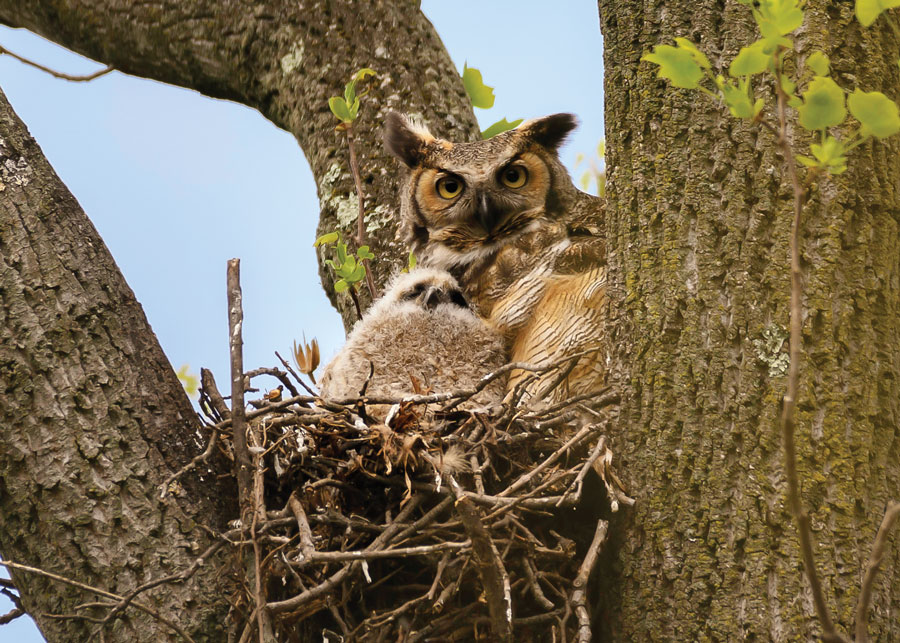
Five species of owls live in northern New Jersey year-round: the Great Horned, Barn, Northern Saw-whet, Barred and Eastern Screech Owls. Three migrate from colder breeding grounds: the Snowy, and Long-eared and Short-eared Owls. All hunt for food at night or at dusk and dawn, using their superb sense of hearing and a satellite-style faceplate to locate their prey that often live underground. Their ears are holes covered by feathers. They use each ear independently to hear their prey, then rotate their disc-like faceplate like a satellite structure to point at the prey’s exact location. This is known as “sound triangulation.” They are noted for incredible, almost hi-tech location strategy, and silent, precision flying. Sometimes the raptors are chased and dive-bombed by songbirds, crows and other rambunctious groups of little birds protecting their nests and offspring. Owl eggs and chicks are also eaten by a medley of wild creatures. All owls fly silently. They have a shorter wingspan proportionally in general because they are arboreal. A shorter wingspan is more advantageous in a woodland. In most raptor species, the female is bigger than the male.
Doro is a Great Horned Owl that came to The Raptor Trust in Millington, New Jersey, in September 2012 with a twisted and turned broken right wing. Since then, after much rehabilitation, her broken wing has mended, but not to full capacity for safe, sustainable flight. Doro is a full-time resident at The Raptor Trust (TRT) and these days she has a job to do – fostering an orphan baby from the wild. Though the center’s staff raises chicks and older birds in captivity, “a female that shows some signs for laying an egg or an inclination to mate may be a good candidate to foster, rather than us. It gives the chick an advantage in the wild,” says Chris Soucy, Executive Director at The Raptor Trust. Such a bird is Doro. A chick must be fully grown and fully feathered, independent and able to catch its own food before it’s released into the wild. Great Horned Owls fledge at eight to ten weeks.
Great Horned Owls tend to nest early, in February or March. “They’re squatters,” says Soucy. “They are terrible architects and steal nests from other large birds such as Crows and Red-tailed Hawks.” These powerful birds sometimes damage the nest (or find a ragged, used one from the previous year) but never fix it, frequently to the detriment of falling chicks that often end up at TRT. Chicks are nestlings for six to seven weeks, then venture out onto branches (called branchers) but, still clumsy and vulnerable, they need a little more time to grow. They may try to fly before they’re ready “like teenagers with permits that don’t yet have their driver’s licenses,” as Soucy says. About the eighth week, when they’re out of the nest, but before they are set free, they receive “occupational therapy” and learn to hunt and a chance to fly. The nestling owls and many rehab birds at TRT are fed killed mice.
Out in the wilds of Nature, the Great Horned Owl of story books is common and ubiquitous. Their preferred habitat is second growth woodlands, farms and orchards and backyards and cities. Their diverse cuisine features mammals, birds, rodents, reptiles, insects and occasionally another owl. They are loudly territorial with hoots, hisses and screams accompanied by wing-flapping and feet-fighting.
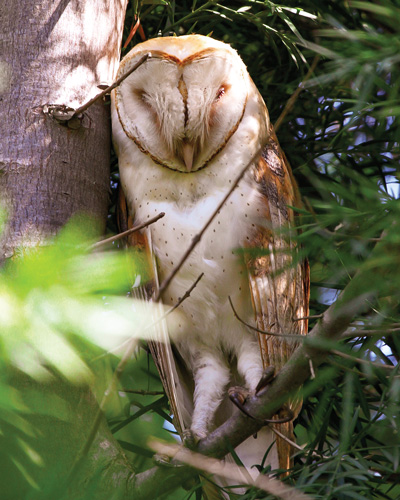
The Barn Owl, a medium-size bird with a white, heart-shaped face with dark eyes is of “special concern” in New Jersey. These tuftless owls are running out of territory: farmland, woodlots with large, old trees hollowed out by decay and large barns and abandoned buildings – anywhere with a big cavity. They are threatened by developed farmland, poisoned rodents/food supply and loss of large, hollow trees and run-down, deserted buildings and being hit by cars at night while flying low along fields. Holes in dead trees and man-made structures, including nest boxes and drive-in movie screens provide nesting sites. Females make the nests with regurgitated pellets, then shred them with their feet. They give birth to clutches of four to eight young. Barn Owls use sound triangulation and their excellent low-light vision to locate rodents in fields at night. The male attracts a female by hovering in front of her and dangling his feet, then remains monogamous. What to do: Plant a hedgerow along a road adjacent to a field. Put up a nest box. Where to see them: In the headlights at night near an open field.
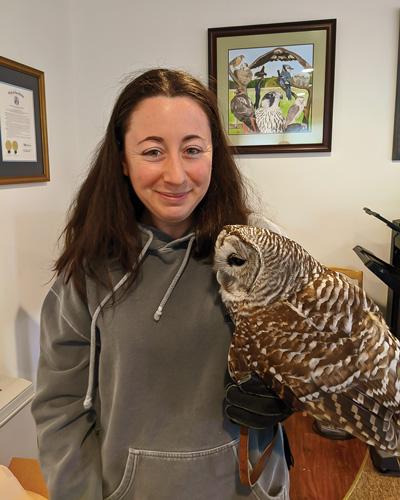
Sonny, a Barred Owl with vertical stripes on his belly is roughly seven years old. Sonny was found on the ground as a nestling with a broken wing and brought to The Raptor Trust. The wing was mended and splinted but did not heal with full flexibility for flying. Sonny eats his share of rats and mice and, in return, visits schools to educate kids. Barred Owls can walk up tree trunks by using their feet, beak and flapping wings. They have round heads, dark eyes and streaks on the chest. They eat small rodents, rabbits, birds, reptiles, insects and fish. Their method is to sit and wait on a perch, watching and listening, then drop down for the catch, and swallow the prey headfirst. In turn, the Great Horned Owl is the Barred Owl’s most serious predator, followed by other owls, hawks, weasels and raccoons. Large cavities near water, preferably in mature mixed forests and stick nests built by other birds twenty-to-forty feet high are favorite nest sites. The owls roost on branches and in cavities by day.
What to do: Build a nest box. Where to see them: Listen for their call at night. Learn it and use it to attract a territorial owl. Visit a forest near water.
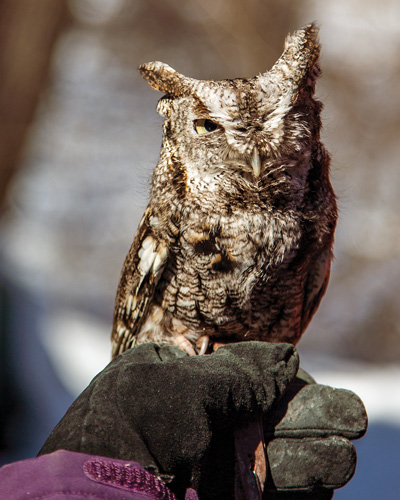
At Raptor Trust, a tiny ball of fluff stares out from a branch on a fake Christmas tree. This is Winky, an Eastern Screech Owl, the size of a robin. The tiny creatures send out a giggly trill in the dead of night. Habitat includes farmland, suburbs and city parks where life can be easier with more prey and fewer predators. On the hunt, they sit and wait on a tree branch six feet high; then pounce when prey passes below. The smallest and most common owl in New Jersey, the Screech Owl lives in small family groupings and nests in tree cavities, bird houses, nest boxes, crates and wood piles. The female lays her eggs on whatever luck has provided. The male may have several females and nests in his territory.
What to do: Leave some dead trees. Put up a nest box and bird bath in your backyard. Where to find them: Find a tree and you might find this bird, even in your own backyard. Their daytime garb is fabulously camouflaged and meant to fool the world. If you see one in the day, you might think it’s part of the tree trunk. Listen for them in wooded areas. Perhaps you can locate them by catching a cacophony of harassing songbirds. And look in tree holes on a cold, sunny day. You might get lucky!
Northern Saw-whet Owl a tiny owl with a big head is one of the most common yet seldom seen owls. They roost in dense conifer forests and stands. Mice, voles, baby mammals, birds and insects are their prey. They prefer an open mixed forest near water for roosting and nesting, and sand dunes and poplar plantations! They nest in deep, narrow tree holes and used nest boxes. When a female responds to a male’s mating call, he circles here about twenty times, the drops beside her with a gift of prey. The female leaves when the youngest nestling is eighteen days old and the male assumes care of the chicks, although he keeps a messy nest. Every year, they find new mates. Saw-whet’s predators include owls, hawks and falcons.
What to do: Allow dead trees to stand for nest cavities. Build a nest box. Where to find them: They roost in dense conifer foliage close to the ends of branches. Watch songbirds. A noisy flock may be determined to chase a Saw-whet away. Listen for them in winter and early spring. Heed the noisy songbird gangs intent on driving the Northern Saw-whet Owl away.
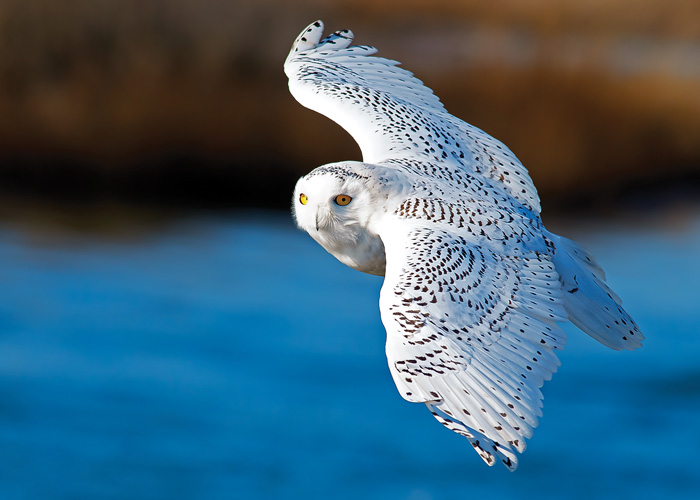
Snowy Owls, all dressed in white with cat-like eyes, hunt and breed in a summer world of 24-hour daylight and feed on lemmings and ptarmigan. These heaviest of owls fly to the Garden State in winter from the tundra north of the Arctic Circle above the treeline. This bird likes open spaces without trees. They sit on the ground to hunt, perched on a slight slope. In winter in New Jersey, they perch on fenceposts, buildings and other structures. This nimble bird nabs other birds on the fly. Snowy Owls sit a lot, especially when hunting, using their exceptional vision and hearing to locate prey— even a critter moving under the snow. On the tundra, mating dances are show-stoppers. With prey in his mouth, the male flies like an acrobat. On the tundra, they nest on the ground on an incline. The female scrapes out a shallow depression and shapes it to her body to lay a clutch of three to eleven eggs. Territorial defense means looking bigger to other Snowy Owls and dive-bombing other creatures including humans and wolves.
Where to find them: Look for the Snowy Owl in fields and along shorelines. Search the obvious poles, fenceposts and buildings. Always look for a bevy of noisy, mobbing birds
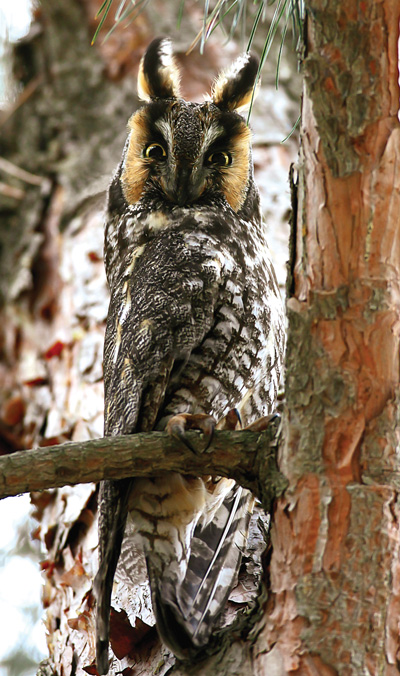
With a call of one hoot and a keen sense of hearing, the Long-eared Owl (actually long-tufted) can seize its prey in total darkness. Though deftly camouflaged, you can hear their long-distance hoots on summer nights. In New Jersey winters they roost in large numbers in stands of pine and other trees with dense branches. They hunt in open grasslands for small mammals, rodents, rabbits and occasionally small birds, catching their prey in flight or when hovering. Long-eared Owls don’t build nests. They usually take over deserted stick nests. They are a social owl, forming loose colonies when nesting even with other bird species. When roosting, a hundred birds might gather. Males do a flamboyant aerial dance when courting.
Where to find them: Look for two-to-three-inch pellets, feathers and whitewash on the ground and lower branches. Look for a group of owls roosting in pine stands near fields and pastures.
When the Short-eared Owl comes to New Jersey in winter, it hunts at dawn and dusk over open fields for small mammals and birds, beheading and gutting them before eating. The Short-eared Owl resides globally and flies over long stretches of ocean, and on occasion hitches a ride on a ship. It nests on dry sites with tall grasses and low foliage and reclaimed and repainted strip mines. The female builds her own nest. She scrapes out a shallow hole and softens it with grasses and down. Winter habitat varies for these ground nesting birds: marshes, fields, dumps, gravel pits and open areas with low foliage. They roost in trees. These feisty owls spar and court with their talons while tumbling. Their populations decline with increased usage of open fields, agriculture, development and fragmented open areas.
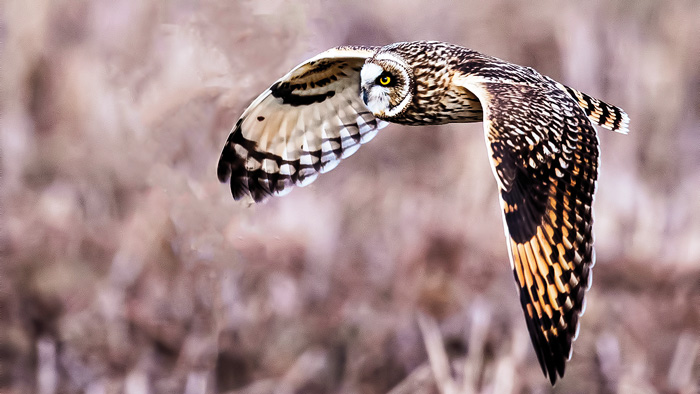
Where to find them: Look in daylight in open fields and airports.
The Raptor Trust is one of the premier wild bird rehabilitation centers in the United States.1452 White Bridge Road, Millington 07946, 908/647-2353
The
Cornell Lab of Ornithology is a prime source of information about birds of all kinds.